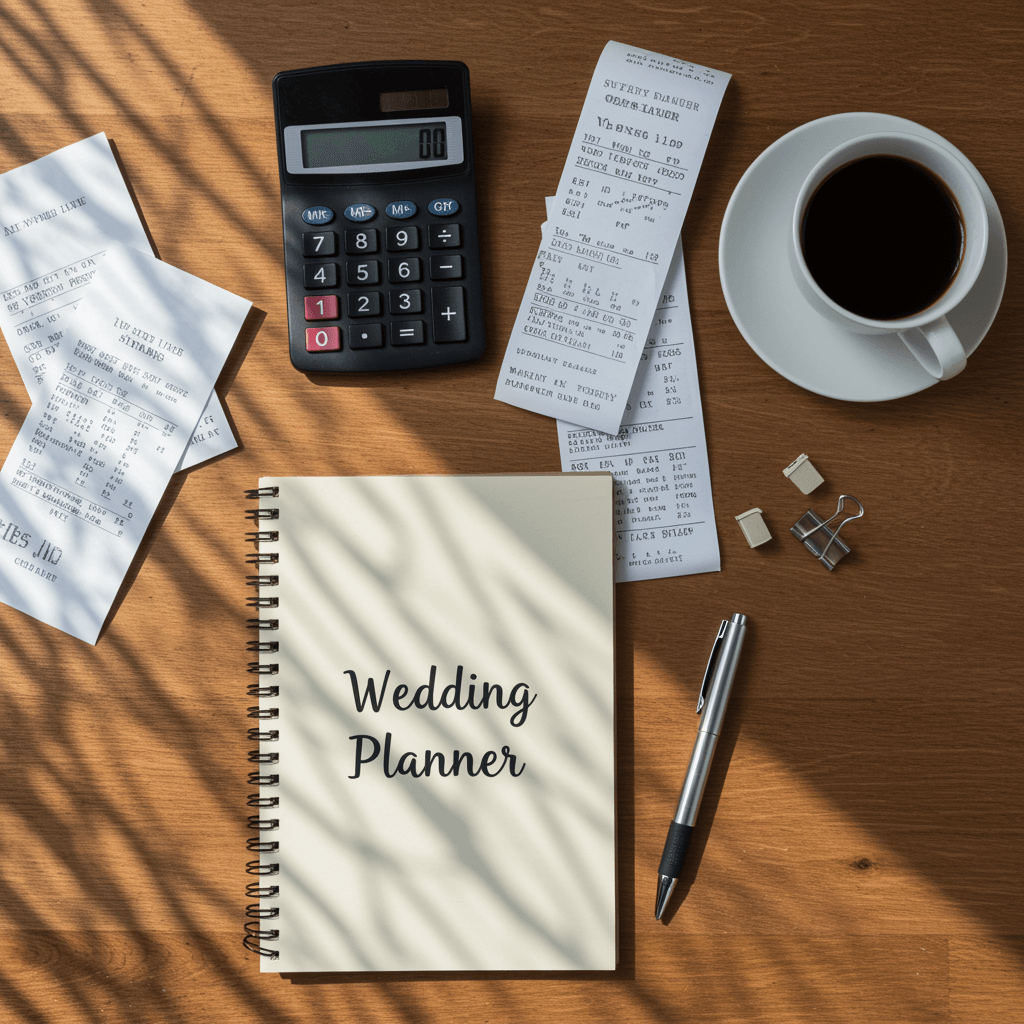Planning a wedding is one of the most exciting — and financially complex — projects you’ll ever take on. When choosing the venue, attire, catering, and entertainment, it’s easy for costs to spiral out of control. Therefore, having a clear wedding budget breakdown is essential. Not only it helps you see where every dollar goes and prioritize your spending, but also make sure you get the celebration you’ve always dreamed of — without unnecessary stress.
When you create your wedding budget, you gain control over every aspect of the planning process. You’ll understand the average cost of major elements, learn how to allocate funds wisely, and find smart ways to stretch your budget without sacrificing quality or style.
How To Build Your Wedding Budget
The first step in wedding planning is deciding how much you can afford overall. As soon as you set that total, it’s time to build a detailed breakdown that outlines every major category of expense. This is where the real clarity comes in.
Here’s a simplified structure to start with:
- Venue and Rentals – 30–40%
- Catering and Cake – 20–25%
- Photography and Videography – 10–12%
- Attire and Beauty – 8–10%
- Flowers and Décor – 8–10%
- Entertainment and Music – 5–8%
- Stationery and Invitations – 2–3%
- Transportation – 2–3%
- Miscellaneous and Tips – 5%
Every couple’s priorities differ, so your wedding cost distribution might vary. The key is to make a plan that reflects what matters most to you both.
Setting Priorities Before You Start Spending
Before booking your wedding venue or signing contracts, sit down together and discuss what’s truly important. Maybe you want a breathtaking location, or perhaps photography and videography top your list. By setting clear priorities, you can channel more of your budget toward those elements and trim costs elsewhere.
For instance, if you dream of an outdoor garden wedding, you may spend more on décor and rentals but save on a venue fee. Or, if a live band is your dream entertainment, you might adjust your catering package to balance things out.
Understanding The Average Wedding Cost
Every couple wonders: what’s the average cost of a wedding? While this figure varies by region and season, many U.S. weddings now range from $25,000 to $40,000. But remember — your wedding budget doesn’t have to match anyone else’s.
The best approach is to make realistic choices that fit your lifestyle and long-term financial goals. Whether you’re planning a luxury event or an intimate backyard celebration, the principles of smart budgeting remain the same.
Breaking Down Wedding Expenses By Category
Let’s explore a detailed wedding budget breakdown to help you estimate where your money will go.
Venue And Rentals
Your wedding venue will likely be your largest single expense. It includes not just the space but also tables, chairs, linens, and décor rentals. If you’re open to creativity, consider weekday weddings or off-season dates to stretch your budget further.
Catering And Cake
Food and drinks are vital to a memorable experience. Decide early on whether you want a plated dinner, buffet, or cocktail-style service. A professional caterer can help you balance guest satisfaction with your budget.
Photography And Videography
Capturing your big day is priceless. Photography preserves every smile and detail, while videography lets you relive the emotions again and again. Choose experienced professionals whose style resonates with you, even if it means adjusting other parts of your wedding budget.
Wedding Attire And Beauty
Your wedding attire should make you feel incredible. Whether you’re investing in a designer gown or renting a suit, factor in accessories, alterations, and professional hair and makeup.
Flowers And Décor
Floral arrangements and décor set the mood for your celebration. With this in mind, work with a florist to create designs that complement your theme without exceeding your budget. Repurposing ceremony flowers for the reception is a great cost-saving trick.
Entertainment And Music
From DJs to live bands, the entertainment keeps guests engaged. Discuss playlists, timing, and setup requirements in advance to avoid unexpected wedding expenses later.
Transportation
Whether it’s a limousine, vintage car, or shuttle bus, transportation ensures everyone arrives on time and in comfort. Don’t forget to include travel costs in your planning process.
Stationery And Invitations
Your invitations set the tone for your wedding. Many couples now create digital or hybrid designs to save on printing costs while maintaining elegance.
Hidden Costs You Shouldn’t Overlook
Even with the best planning, certain wedding expenses sneak up unexpectedly. These might include:
- Marriage license fees
- Vendor tips and service charges
- Overtime costs for photographers or musicians
- Postage for invitations and thank-you cards
- Dress cleaning or preservation
By building a small contingency fund — around 5–10% of your total — you’ll be ready to cover surprises without stress.
Tips To Stretch Your Budget And Save Smartly
You don’t have to sacrifice style to stretch your budget. Here are practical strategies to make your money go further:
- Prioritize quality over quantity. Fewer guests mean lower costs for food, rentals, and décor.
- DIY selectively. You can make your own centerpieces, signage, or favors if you have time.
- Negotiate respectfully. Many vendors offer discounts for weekday or off-peak weddings.
- Bundle services. Some venues include catering, rentals, or even coordination, reducing total wedding cost.
- Hire a wedding planner. A professional wedding planner can help you create a realistic timeline, manage vendors, and prevent overspending.
How To Make Your Wedding Budget Work For You
Your wedding planning journey will be smoother when you make your budget flexible. Track spending in a spreadsheet or app, update totals after each payment, and adjust as needed. When unexpected expenses arise, shift funds from less important areas instead of increasing your total.
By learning to create and manage your wedding budget, you ensure that every choice aligns with your vision and finances. The goal isn’t perfection — it’s balance.
Sample Wedding Budget Example
Here’s a simple sample budget for a $30,000 wedding to give you a realistic starting point:
| Category | Estimated Cost | Percentage |
|---|---|---|
| Venue & Rentals | $9,000 | 30% |
| Catering & Cake | $6,000 | 20% |
| Photography & Videography | $3,600 | 12% |
| Attire & Beauty | $2,700 | 9% |
| Flowers & Décor | $2,400 | 8% |
| Entertainment | $1,800 | 6% |
| Stationery & Invitations | $900 | 3% |
| Transportation | $600 | 2% |
| Miscellaneous | $2,000 | 7% |
This wedding budget breakdown can serve as a flexible guide. Adjust it based on your personal preferences and priorities.
Final Thoughts: Create A Celebration You’ll Love
Without a doubt, your wedding should reflect who you are as a couple — not how much you spend. Overall, with thoughtful planning, realistic expectations, and a smart wedding budget breakdown, you can design a day that feels luxurious and meaningful without financial regret.
Remember, it’s not about following rigid numbers — it’s about making decisions that bring joy, connection, and unforgettable memories.













